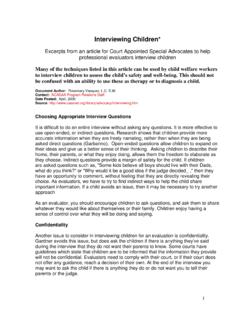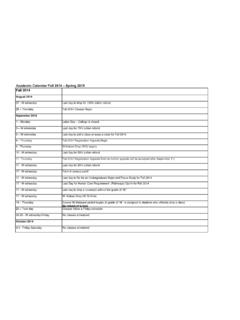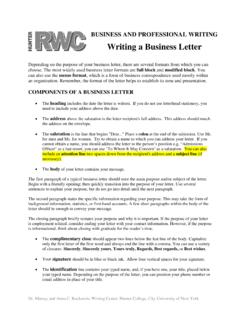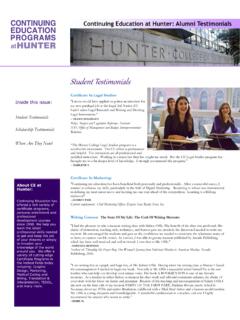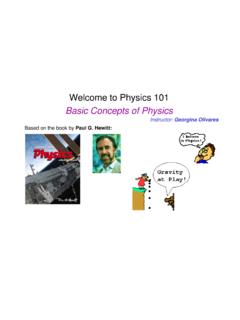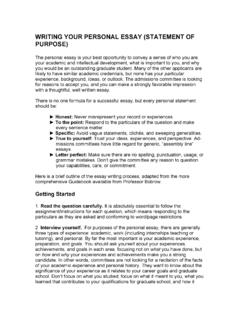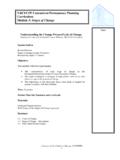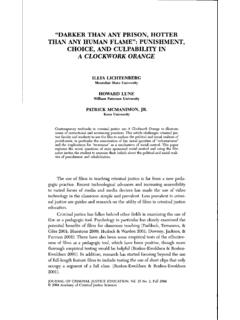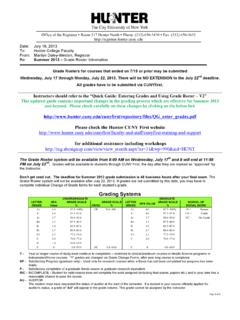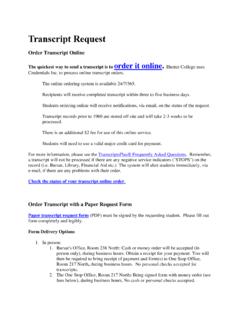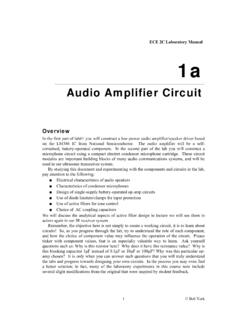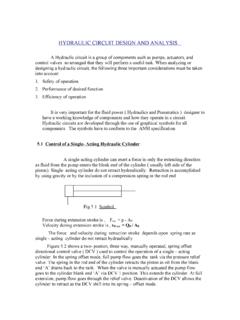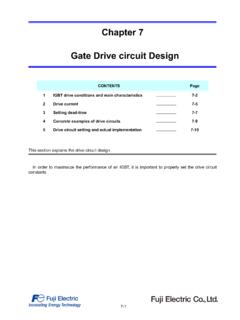Transcription of 11. The Series RLC Resonance Circuit
1 11. The Series RLC Resonance CircuitIntroductionThus far we have studied a Circuit involving a (1) Series resistor R and capacitor C Circuit as wellas a (2) Series resistor R and inductor L Circuit . In both cases, it was simpler for the actual experiment toreplace the battery and switch with a signal generator producing a square wave. The current through andvoltage across the resistor and capacitor, and inductor in the Circuit were calculated and lab involves a resistor R, capacitor C, and inductor L all in Series with a signal generator andthis time is experimentally simpler to use a sine wave that a square wave. Also we will introduce thegeneralized resistance to AC signals called "impedance" for capacitors and inductors. The mathematicaltechniques will use simple properties of complex numbers which have real and imaginary parts.
2 This willallow you to avoid solving differential equations resulting from the Kirchoff loop rule and instead youwill be able to solve problems using a generalized Ohm's law. This is a significant improvement sinceOhm's law is an algebraic equation which is much easier to solve than differential equation. Also we willfind a new phenomena called " Resonance " in the Series RLC 's Loop Rule for a RLC CircuitThe voltage, VL across an inductor, L is given by(1)VL=Lddti@tDwhere i[t] is the current which depends upon time, t. The voltage across the capacitor C is (2)VC=Q@tDCwhere the charge Q[t] depends upon time. Finally the voltage across the resistor is (3)VR=i@tDRThe voltage produced by the signal generator is a function of time and at first we write the voltage of thesignal generator as V0 Sin@wtD where V0is the amplitude of the signal generator voltage and w is thefrequency of the signal generator voltage.
3 What we actually have control over is the signal generatorvoltage frequency f measured in Hz and w=2pf is the relationship between the two frequencies. voltage produced by the signal generator is a function of time and at first we write the voltage of thesignal generator as V0 Sin@wtD where V0is the amplitude of the signal generator voltage and w is thefrequency of the signal generator voltage. What we actually have control over is the signal generatorvoltage frequency f measured in Hz and w=2pf is the relationship between the two frequencies. Combining equations (1) through (3) above together with the time varying signal generator we getKirchoff's loop equation for a Series RLC Circuit . (4)Lddti@tD+Q@tDC+i@tDR=V0 Sin@wtDYou can now take the time derivative of equation (4) and use the definition of current i[t]=dQ[t]/dt to geta linear, second order Inhomogeneous differential equation for the current i[t](5)Ld2dt2i@tD+i@tDC+Rddti@tD=V0wCos@ wtDYou can solve the differential equation (5) for the current using the techniques in previous labs (in factequation (5) has the same for as the driven, damped harmonic oscillator).
4 Equation (5) is a linear, secondorder, Inhomogeneous ordinary differential equation and it is a little complicated to solve. However it issimpler to solve electronics problems if you introduce a generalized resistance or "impedance" and thiswe do. When introduce complex numbers, the solution to circuits like the Series RLC Circuit becomeonly slightly more complicated than solving Ohm's law. But first we must review some properties ofcomplex numbers. This will take a little time but it is more than worth Properties of Complex Numbers The complex number z can be written(6)z=x+ yNote that the in equation (6) is the imaginary number =-1 and = is the natural you can distinguish between the imaginary number and the current i in the equations might be helpful to think of complex numbers as vectors in a two dimensional vector space such thatthe horizontal component is the real part of the vector and the imaginary part of the vector is the we will write x= [z] by which we mean take the Real Part of the complex number z andwe will also write y= [z]] by which we mean take the Imaginary Part of the complex number z.
5 Itmight make complex numbers a little less mysterious by thinking of z as a vector in a two dimensionalvector space. The complex conjugate z*of a complex number z is defined(7)z*=x- yso z* is the mirror image of z. Operationally if you have a complex number z you can construct thecomplex conjugate z* by changing the sign of the imaginary part of z. Sometimes it is convenient to write a complex number in a polar form having a radius component r andan angular position relationship between the rectangular components x and y and the polar coordinates r and q is imply(8)x=rCos@qDandy=rSin@qDthat is, given r and q you can calculated x and y using equations (3). Note from the Pythagorean theo-rem (9)r2=x2+y2orr=x2+y2and (10)Tan@qD=x yorq=ArcTan@x Euler RelationshipThe Euler relation allows you to write f is a simple an useful form(11) f=Cos@qD+ Sin@qDAt first this formula appears mysterious but it is easily proved using the Taylor Series of q which is(12) f=1+ f+H fL22!
6 +H fL33!+H fL44!+H fL55!+H fL66!+..and note that 2=-1 , 3=- , 4=1, 5= , 6=-1, .. so tha pattern repeats every four terms. Theexpansion on the right hand side of equation (12) has odd power terms which are real and even powerterms that are imaginary. Grouping the real terms together and the imaginary terms together you note that 2=-1 , 3=- , 4=1, 5= , 6=-1, .. so tha pattern repeats every four terms. Theexpansion on the right hand side of equation (12) has odd power terms which are real and even powerterms that are imaginary. Grouping the real terms together and the imaginary terms together you get(13) f=1-f22!+f44!-f66!+..+ f-f33!+f55!-f77!+..The group of terms in the first set of parenthesis on the right hand side equation (13) is the Taylor seriesexpansion of Cos[f] and the group of terms in the second set of parenthesis on the right hand side ofequation (13) is the Taylor Series expansion of Sin[f].
7 Thus equation (11) is a first use of the Euler relationship write(14)z=r qwhich becomes after using the Euler relation (11)(15)z=rHCos@qD+ Sin@qDLand thus after rearrangementz=rCos@qD+ rSin@qDComparison of this equation and equation (6) yieldsx=rCos@qDandy=rSin@qDwhich we knew as equation (8). This should give you a little more confidence in the Euler equations can also be used to write (16)yx=Tan@qDandthusq=ArcTan@qDr is sometimes called the "magnitude" of the complex number z and q is called the "phase angle". Recallthat the complex conjugate z* of the complex number z is z*=x- y and using equations (8)(17)z*=rCos@qD- rSin@qDFurthermore since the Cos[q] is an even function of q we write Cos[q]=Cos[-q] and since Sin[q] is an oddfunction of q we may write Sin[q] = -Sin[-q] and equation (17) may be written(18)z*=rCos@-qD+ rSin@-qDand if you look at equation (11) or equation (14) it is clear equation (18) may also be written(19)z*=r - qThus the complex conjugate of z written in polar form is obtained by keeping r as it is and changing thesign in the exponent of equation (11).
8 These are just about all the properties of complex numbers weneed. using Complex Numbers We will need to add two complex numbers z1=x1+ y1 and z2=x2+ y2(20)z=z1+z2but to do this you just as the real parts to get x=x1+x2 and the imaginary parts to get y=y1+y2. Itshould be obvious how you subtract one complex number from of two complex numbers is obtained easily as well(21)z1z2=Hx1+ y1 LHx2+ y2 LThe binomial on the right hand side of equation (21) when multiplied out results in four terms two ofwhich are real and two of which are imaginary(22)z1z2=Hx1x2-y1y2L+ Hx1y2+x2y1 Lwhere we also used 2=-1. Note in particular if the two numbers are z= x+ y and its complex conju-gate z*=x- y the imaginary part of the product zz* and we get a real number answer for the product (23)zz*=Ix2+y2M=r2andr=x2+y2where the last equality follows from equation (9).
9 R obtained by taking the square root of equation (9) issometime called the magnitude of the complex number or just "magnitude". A complex number can bealso written(24)z=r fThe multiplication of two numbers is much simpler in polar form (11). Let the two complex numbers bez1=r1 q1 and z2=r2 q2 so the product is(25)z1z2=r1 q1r2 q2and thus after rearrangement and using the property of multiplication of exponentials(26)z1z2=r1r2 Hq1+q2 LYou can also divide one complex number z1 by another z2. (Note that complex numbers are a littledifferent from a two dimensional vector space since you cannot divide one vector by another but you candivide one complex number by another.) Division is most easily done in polar coordinates(27)z1z2=r1 q1r2 q2 The right side of equation (26) may be (28)z1z2=r1r2 Hq1-q2 Lsince a property of exponential allows you to write (29)1 q= - qIf you divide one complex number by another in rectangular coordinates then(30)z1z2=Hx1+ y1 LHx2+ y2 LThe answer we want for the quotient is a real plus and imaginary number.
10 We know from equation (23)we know that multiplying a number by its complex conjugate yields a real number. So it makes sence tomultiply the denominator to equation (29) by its complex conjugate and if we do the same to the numera-tor we have not changed anything because this is just multiplying by one(31)z1z2=Hx1+ y1 LHx2+ y2 LHx2- y2 LHx2- y2L=Hx1x2+y1y2L+ Hy1x2-x1y2 LIx22+y22 MSo we have achieved are goal of writing the quotient as a real number plus and imaginary numberspecifically(32)z1z2=Hx1x2+y1y2 LIx22+y22M+ Hy1x2-x1y2 LIx22+y22 MSolving the Series RLC Circuit with Complex Numbers Suppose the signal generator voltage is a Sine function Vs@tD=V0 Cos@wtD where the amplitude V0is a real number. Using the Euler formula we also know that signal generator voltage can be wtEWe want to solve for the current i[t] in the Series RLC Circuit and this current is the same everywhere inthe Circuit by conservation of charge.
